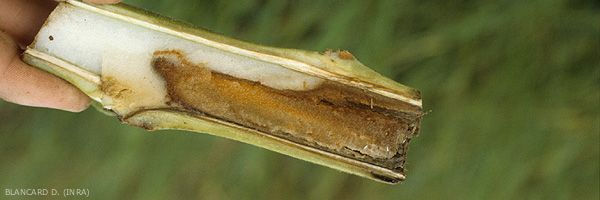
Pectobacterium spp. Waldee (1945)
Black soft rot of stem and leaves
- Synonym : Erwinia spp.
- English names : Black leg, Hollow stalk, Barn rot
Pectobacterium spp. is a bacteria complex that includes several subgroups which may cause damage on tobacco. Undoubtedly the most common is Pectobacterium carotovorum subsp. carotovorum (Jones) Hauben et al. (e.g. Erwinia carotovoraJones Waldee, figure 1) which is often associated with wet rot observed on seedlings and on mature tobacco plants. Pectobacterium chrysanthemi (Burholder et al.) Brenner et al. is incountered less frequentely and usually only in the curing barns.
Pectobacterium spp. are present worldwide. They have been reported on tobacco in every country where this crop is grown. In general they only occasionally cause severe
damage on mature tobacco, usually as a result of very favourable wet weather conditions (figure 2). In some humid tropical and subtropical countries, these pathogens represent a more constant threat to tobacco crops and sometimes considerable losses are observed. In the U.S., significant losses have been recorded during curing of Virginia type of tobacco (barn rot). In Europe in general, and France in particular, the incidence of this disease is low. Diseased plants may be observed in a low frequency in some fields. In recent years significant losses due to these bacteria have not been observed during tobacco curing.
China situation
In 2015, Pectobacterium carotovorum subsp. carotovorum and P. c. subsp. brasiliense which caused bacterial leaf rot on tobacco in different fields, appeared in Shaowu city, Fujian Province, China. It infects mature leaves causing bacterial leaf rot disease in the topping stage growing season. A typical symptom was necrosis along the main or lateral veins, eventually causing the leaves becoming dry and rotten, but necrosis did not spread to the stem (figures 3 and 4). The dry rot symptom formation is because of the solid and less juicy leaf tissues.
The appearance of this disease in fields is generally preceded by high humidity or temperature or both. When tobacco leaves were near maturity after topping stage, a humid atmosphere caused by high temperature and rain, mechanical injuries by rain drop and artificial bud inhibition occured on veins. Therefore, P. c. subsp. carotovorum and P. c. subsp. brasiliense could invade leaf through wounds, resulting in necrosis and dry rotten veins under favorable conditions, and finally destroy the entire leaf.
(Jing Wang - Tobacco Research Institute, Chinese Agricultural Academy of Science, China)





